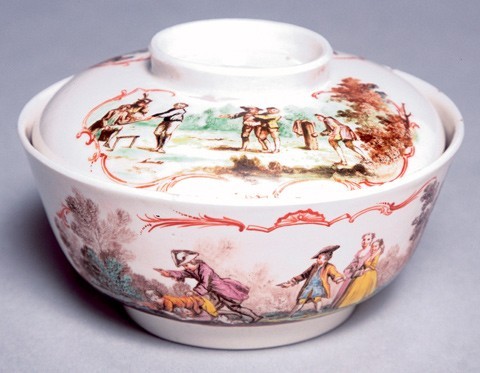
Covered bowl, East London, England, ca. 1744. Porcelain. H. 3 1/8". (Melbourne Cricket Club Museum Collection; courtesy of the National Sports Museum, Melbourne Cricket Ground. Acc. No. M569.1; photo, Erin O'Brien.) Decorated in enamels and marked on the base with an “A” in underglaze blue. This sugar bowl and cover, formerly in the Baer collection, are composed of a mixture of China clay and lime-soda frit in the proportion 60:40 (hydrous). This composition conforms to the 1744 patent of Heylyn and Frye, and it is proposed that whoever made this bowl was replicating the 1744 patent, which specified the use of Cherokee clay. This covered bowl is part of a partial tea set comprising a teapot and cover (see fig. 7), a cream jug, and three saucers.
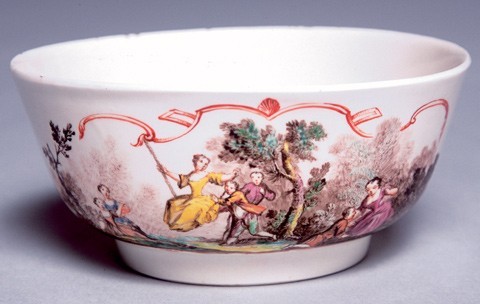
Side view of bowl illustrated in fig. 1. (Melbourne Cricket Club Museum Collection; courtesy of the National Sports Museum, Melbourne Cricket Ground. Acc. No. M569.1; photo, Erin O'Brien.) The vignette Swinging on the Rope, located on one side of the covered bowl, is derived from a set of engravings by James Cole titled The Second Part of Youthful Diversions, 1739. The palette comprises an iron red, as seen in the scrolled cartouche. In addition there is blue-green, grass green, vibrant mid-blue, brown grading to dark brown, black, purple, and shades of bright yellow either thickly applied, as on the girl’s skirt, or applied as a thin wash. Flesh pink is derived from mixing a buff color with very minor iron red. This range of colors is somewhat similar to the palette displayed on many early Bow phosphatic wares.
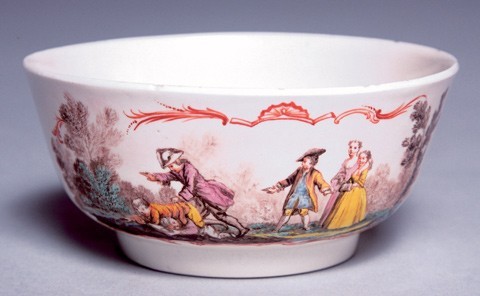
Side view of bowl illustrated in fig. 1. (Melbourne Cricket Club Museum Collection; courtesy of the National Sports Museum, Melbourne Cricket Ground. Acc. No. M569.1; photo, Erin O'Brien.) This vignette, Youth Sliding on the Ice, is located on the reverse side of the bowl and is also derived from James Cole’s The Second Part of Youthful Diversions, 1739.
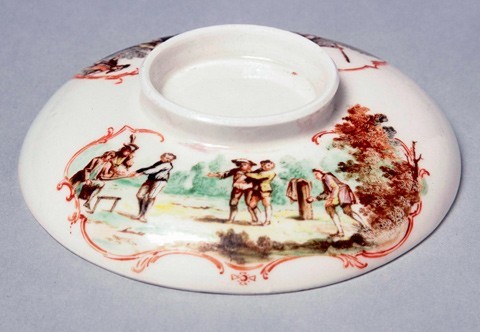
Cover of bowl illustrated in fig. 1. (Melbourne Cricket Club Museum Collection; courtesy of the National Sports Museum, Melbourne Cricket Ground. Acc. No. M569.1; photo, Erin O'Brien.) Diam. 4 7/8". This scene, inscribed “YOUTH PLAYING AT CRICKET,” is derived from James Cole’s The Second Part of Youthful Diversions, 1739, and proved to be one of the main factors that led Charleston and Mallet in 1971 to propose a British rather than Continental origin for the A-marked group of porcelains.
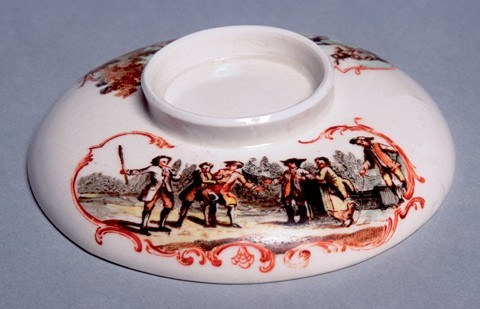
Cover of bowl illustrated in fig. 1. (Melbourne Cricket Club Museum Collection; courtesy of the National Sports Museum, Melbourne Cricket Ground. Acc. No. M569.1; photo, Erin O'Brien.) View of the vignette Throwing at Cocks derived from Youthful Amusements, published by James Cole, 1740.
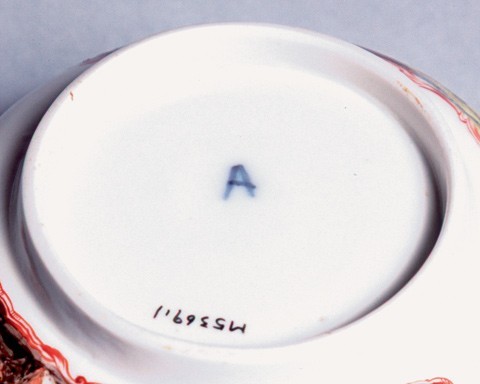
Base of the bowl illustrated in fig. 1. (Melbourne Cricket Club Museum Collection; courtesy of the National Sports Museum, Melbourne Cricket Ground. Acc. No. M569.1; photo, Erin O'Brien.) View of the “A mark,” which was painted in underglaze blue. It is the occurrence of this letter, either painted or incised, that characterizes the A-marked group. One line of thought has suggested that the A stands for the third duke of Argyll, who was a known patron of the arts at this time and had close links with the Bow manufactory. A more recent, alternative view is that the A commemorates Alderman George Arnold, who is generally regarded as being the financial supporter of the Bow manufactory during its infant years and, by inference, its supporter during the phase of manufacture of these porcelains.

Teapot and cover, East London, England, ca. 1744. Porcelain, decorated in enamels and marked with an underglaze “A” in blue. H. 4 1/2". (© V&A Images/Victoria and Albert Museum, London, www.vam.ac.uk.) The scene shown on the teapot is taken from an engraving by George Bickham Jr. after Gravelot. This was based on the operetta Flora by John Hippisley, first produced on April 17, 1729.
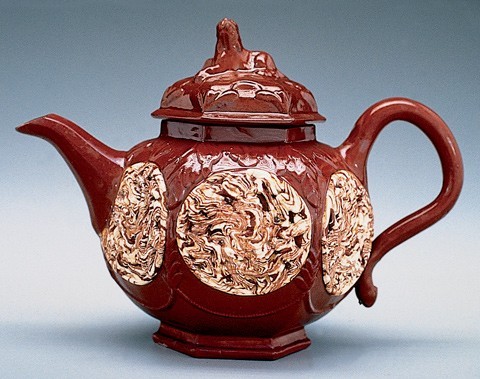
Hexagonal teapot, Staffordshire, ca. 1730–1745. Lead-glazed redware with agate panels. H. 3 7/8". (Chipstone Foundation; photo, Gavin Ashworth.) This slip-cast hexagonal teapot exhibits applied press-molded agate panels of the Chinese-boy-in-a-tree design. A lion finial tops the lid. Examples such as this teapot suggest possible links between some A-marked forms (see fig. 12) and potters derived from Staffordshire.

Fluted cups, East London, England, ca. 1744. Porcelain. H. 2 5/8" and 2 3/8". (Courtesy, Seattle Art Museum, Dorthy Condon Falknor Collection of European Ceramics; photo, Susan Dirk.) The cup on the left is marked with an incised “A” and enameled in the Japanese Kakiemon-style quail pattern, which was used by Meissen, Bow, and, less commonly, by several other early English factories. The form of this slip-cast cup, with its twenty flutes originating from a decagonal low footrim, is a feature of A-marked cups. The white fluted cup on the right, with a somewhat primitive use of applied prunus blossom, leaf, and twig decoration, is one of two examples found occurring in the white and is inspired by a Chinese blanc de chine example. A feature characteristic of but not exclusive to early Bow phosphatic wares is the use of applied prunus blossom. Note the S-shaped handle originating after European silver-derived forms.
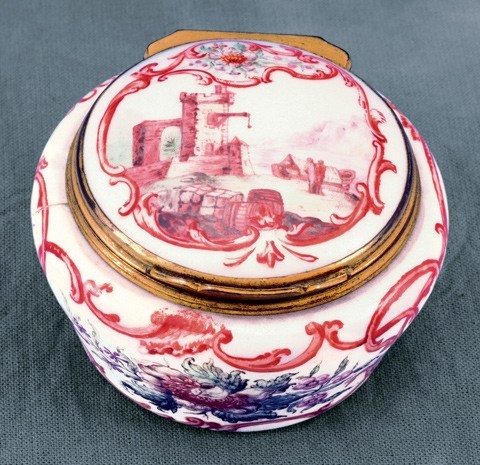
Snuff box, East London, England, ca. 1744. Porcelain. Diam. 2 5/16". (© National Museums and Galleries of Wales, De Winton Collection of Continental Porcelain, acc. no. D.W. 552.) Enameled with an incised “A” or “V.” A scene set within a scrolled cartouche is depicted on the lid. The body is decorated with various flowers and leaves associated with intertwined scrolls.
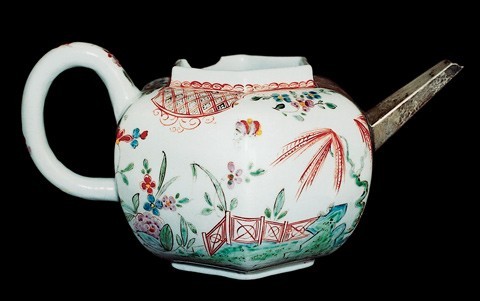
Hexagonal teapot, East London, England, ca. 1744. Porcelain. H. 3 1/8". (Private collection.) Enameled in the Kakiemon style with an incised “A,” this teapot has a replacement silver spout. The palette shows many similarities to the covered bowl and comprises iron red, bluish green, vibrant mid-blue, bright yellow, and mauve. Note that much of the design was initially outlined in thin black and subsequently filled in.

Hexagonal teapot and cover, East London, England, ca. 1743. Porcelain. H. 4 1/16". (Courtesy, © Copyright British Museum.) Both the base of the pot and the inside of the cover are marked with “A” in underglaze blue; the pot is enameled with molded shoulder decoration. The form of this teapot, together with its lion finial, suggest derivation from an unglazed stoneware or a salt-glazed prototype, possibly from Staffordshire or even South London.
